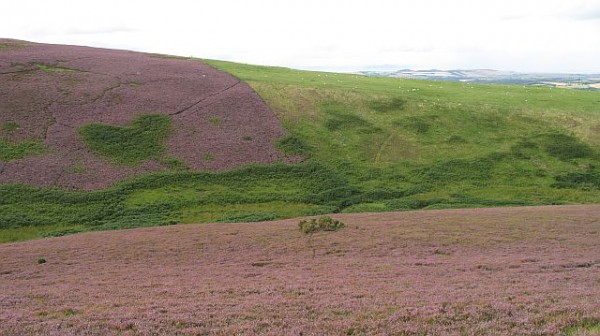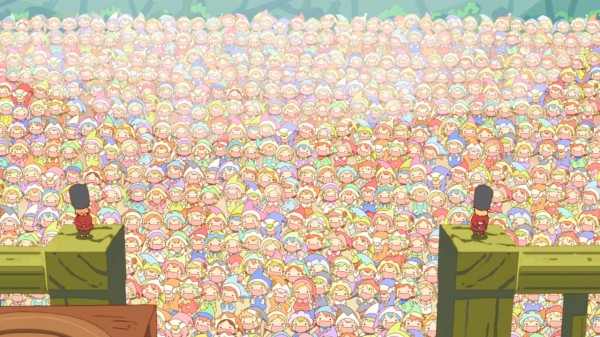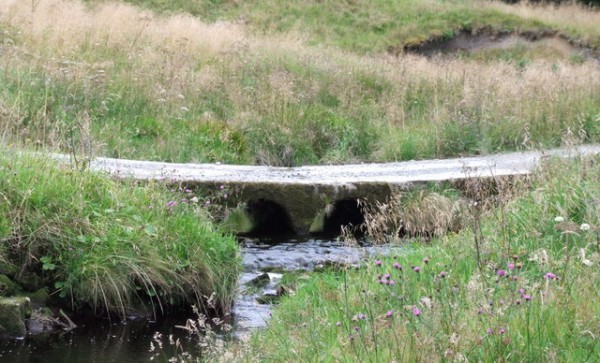Mrs. Rose, of Southend-on-Sea, told us in a chat on the subject: I think I have always seen fairies. I see them constantly here in the shrubbery by the sea. They congregate under the trees and float around about the trees, and gnomes come around to protect them. The gnomes are like little old men, with little green caps, and their clothes are generally neutral green. The fairies themselves are in light draperies. I have also seen them in the conservatory of my house, floating about among the flowers and plants. The fairies appear to be perpetually playing, excepting when they go to rest on the turf or in a tree, and I once saw a group of gnomes standing on each others’ shoulders, like gymnasts on the stage. They seemed to be living as much as I am. It is not imagination. I have seen the gnomes arranging a sort of moss bed for the fairies, just like a mother-bird putting her chicks to bed. I don’t hear any sounds from the gnomes or fairies, but they always look happy, as if they were having a real good time. ( Doyle Coming of the Fairies 167-168)
Tag Archives: Fairy Sightings
Tom Tyrrell Sees Fairies in Yorkshire
Another friend of mine who claims to have the power of seeing fairies is Mr. Tom Tyrrell, the famous medium, whose clairvoyance and general psychic gifts are of the strongest character. I cannot easily forget how one evening in a Yorkshire hotel a storm of raps, sounding very much as if someone were cracking their fingers and thumb, broke out around his head, and how with his coffee-cup in one hand he flapped vigorously with the other to warn off his inopportune visitors. In answer to my question about fairies he says, ‘Yes, I do see these little pixies or fairies. I have seen them scores of times. But only in the woods and when I do a little fasting. They are a very real presence to me. What are they? I cannot say. lean never get nearer to the beggars than four or five yards. They seem afraid of me, and then scamper off up the trees like squirrels. I dare say if I were to go in the woods oftener I would perhaps gain their confidence more. They are certainly like human-beings, only very small, say about twelve or fifteen inches high. I have noticed they are brown in colour, with fairly large heads and standing-up ears, out of proportion to the size of their bodies, and bandy legs. I am speaking of what I see. I have never come across any other clairvoyant who has seen them, though I have read that many do so. Probably they have something to do with Nature processes. The males have very short hair, and the females have rather long, straight hair. Doyle Coming of the Fairies 136-137
Branksome Park Fairy (Dorset)
I was sitting in [Turvey’s] company in his garden at Branksome Park. We sat in a hut which had an open front looking on to the lawn. We had been perfectly quiet for some time, neither talking nor moving, as was often our habit. Suddenly I was conscious of a movement on the edge of the lawn, which on that side went up to a grove of pine trees. Looking closely, I saw several little figures dressed in brown peering through the bushes. They remained quiet for a few minutes and then disappeared. In a few seconds a dozen or more small people, about two feet in height, in bright clothes and with radiant faces, ran on to the lawn, dancing hither and thither. I glanced at Turvey to see if he saw anything, and whispered, ‘Do you see them?’ He nodded. These fairies played about, gradually approaching the hut. One little fellow, bolder than the others, came to a croquet hoop close to the hut and, using the hoop as a horizontal bar, turned round and round it, much to our amusement. Some of the others watched him, while others danced about, not in any set dance, but seemingly moving in sheer joy. This continued for four or five minutes, when suddenly, evidently in response to some signal or warning from those dressed in brown, who had remained at the edge of the lawn, they all ran into the wood. Just then a maid appeared coming from the house with tea. Never was tea so unwelcome, as evidently its appearance was the cause of the disappearance of our little visitors… I have seen fairies several times in the New Forest, but never so clearly as this.’ (Mr Lonsdale) Doyle Coming of the Fairies 133-134
West Sussex Wood Fairy
My only sight of a fairy was in a large wood in West Sussex, about nine years ago. He was a little creature about half a foot high, dressed in leaves. The remarkable thing about his face was that no soul looked through his eyes. He was playing about in long grass and flowers in an open space.’ (Mrs H)132
Blarney Fairies
Miss Winter, of Blarney, in Cork, says: ‘We received communications from a fairy named Bebel several times, one of them lasting nearly an hour. The communication was as decided and swift as from the most powerful spirit. He told us that he was a Leprechaun (male), but that in a ruined fort near us dwelt the Pixies. Our demesne had been the habitation of Leprechauns always, and they with their Queen Picel, mounted on her gorgeous dragon-fly, found all they required in our grounds. He asked most lovingly about my little grandchildren, who visit us frequently, and since then he has been in the habit of com- municating with them, when we have yielded the table to them entirely, and just listened to the pure fun he and they were having to- gether. He told them that the fairies find it quite easy to talk to the rabbits, and that they disliked the dogs because they chased them. They have great fun with the hens, on whose backs they ride, but they do not like them because they jeer at them. When he mentioned the old fort, I thought he referred to Blarney Castle, not far away, but on relating the incident to a farmer’s daughter, whose family has been in the neighbourhood for a very long time, she informed me that a labourer’s cottage at the entrance to our avenue is built on the site of an old fort, information absolutely new to us. Doyle Coming of the Fairies (163-165)
Fairy At Lupton House Devonshire
I had a wonderful little experience some five years ago which proved to me the existence of fairies. One summer afternoon I was walking alone along the avenue of Lupton House, Devonshire. It was an absolutely still day — not a leaf moving, and all Nature seemed to sleep in the liot sunshine. A few yards in front of me my eye was attracted by the violent movements of a single long blade-like leaf of a wild iris. This leaf was swinging and bending energetically, while the rest of the plant was motionless. Expecting to see a field-mouse astride it, I stepped very softly up to it. What was my delight to see a tiny green man. He was about five inches long, and was swinging back-downwards. His tiny green feet, which appeared to be green-booted, were crossed over the leaf, and his hands, raised behind his head, also held the blade. I had a vision of a merry little face and something red in the form of a cap on the head. For a full minute he remained in view, swinging on the leaf. Then he vanished. Since then I have several times seen a single leaf moving violently while the rest of the plant remained motionless, but I have never again been able to see the cause of the movement. (Mrs Tweedale) Coming of Fairies 130-131
Fairies in Worthing?
Mrs. Ethel Enid Wilson, of Worthing, writes: ‘I quite believe in fairies. Of course, they are really nature spirits. I have often seen them on fine sunny days playing in the sea, and riding on the waves, but no one I have ever been with at the time has been able to see them, excepting once my little nephews and nieces saw them too. They were like little dolls, quite small, with beautiful bright hair, and they were constantly moving and dancing about. Doyle, Coming of the Fairies
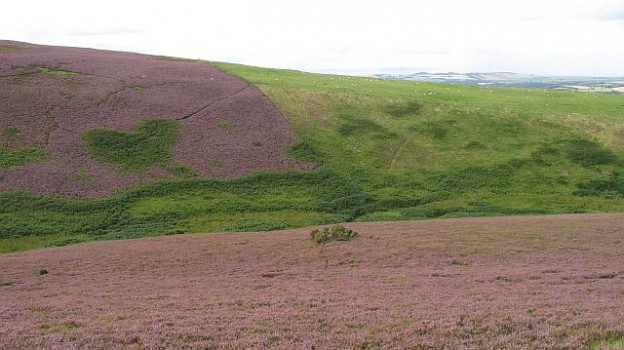
Old Nannie Alnwick Recounts (Northumberland)
Brinkburn and Harehope Hill too they frequented. Old Nannie Alnwick, the widow of the last of the ancient race of Alnwick, the tanners, had faith in the good folk, and set aside for them ‘a loake of meal and a pat of butter,’ receiving, as she said, a double return from them ; and often had she seen them enter into Harehope Hill, and heard their pipe music die away as the green hill closed over them. (Denham 143)
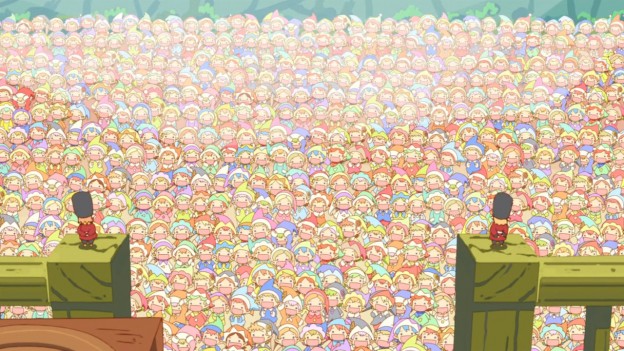
Race at Yetholm
An adventure with the fairies near Yetholm, which unfortunately breaks off abruptly, I find in the MS. of ‘William Jackson, a native of Wooler, supplementary to his brother James Jackson’s enumeration of the inhabitants of that place when he was a young man. It was written in 1837, and James Jackson was then seventy-four years old, and had been absent fifty-five or fifty-six years from Wooler, which affords the date of 1782. ‘My old schoolmistress, Stilty Mary (Mary Turnbull, who lived with her sister Isabel), had a brother whose name was Thomas. He occasionally came from Yetholm and resided with his sisters for a fortnight or three weeks. When Thomas was at Wooler the boys in passing used to shout, ‘Peace be here till Thomas Turnbull, the king’s toller, pass bye.’ This was very annoying to the brother and sisters; and Thomas used sometimes to stand behind the door, with the sneck in his hand, and bolt out upon them, and if he caught hold of any of them the punishment was not so imaginary as the offence. The origin of the reproach was this. Their father was the collector of tolls at Yetholm. He had occasion to visit Edinburgh, and in coming home, a few miles before he reached the town, he came upon a large assemblage of fairies, dressed in green jackets and other splendid equipments, dancing upon a sunny brae to the sound of a great variety of musical instruments and drums. At this sight and sound old Thomas’s horse stood right sore astonished,and startled and curvetted in such a manner as to endanger its rider. In this emergency he bethought himself that the king’s name might possess some authority, so he shouted out with all his might, ‘Peace be here till Thomas Turnbull, the king’s toller, pass bye.’ The fairies were so much engaged with their sport that they had not observed him before; but on hearing the order, instead of obeying it, they came running in great…’ (Caetera desunt.) Denham writes: The remainder cannot be recovered, but Thomas probably won the race that would ensue. (Denham 147-148)
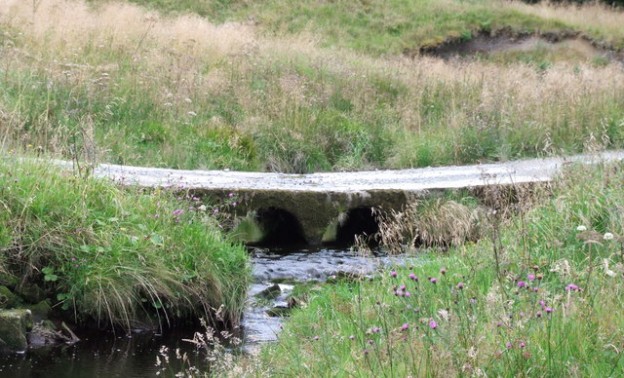
Fairy in Search of Charlie (Co. Antrim)
Michael Laverty told me that about twelve years ago, in the month of June, for three successive evenings, a little man dressed in grey came from the direction of the bridge going to Knocknacarry, and came up nearly to the cross roads, calling out, ‘Hi, Charlie, Charlie.’ On the third evening, Laverty rushed across his garden in front of the forge to intercept and catch him if possible, but the fairy was too quick for him. Laverty once thought he had grasped him, when going over the fence into McGregor’s field, between the mill-race and river, but the fairy vanished. Several persons who were in the forge on the evenings in question heard and saw the wee man, who appeared just at the gloaming, but after this chase he was never seen again. Charles M’Keown, when a boy, at Cushendall fair, was asked for twopence by an ugly wrinkled little man. Being frightened, he gave the money, and then the fairy told him to keep a sharp look out as he was going along, and lo! he found a bank note lying against a Ben-weed. Brenan 61
